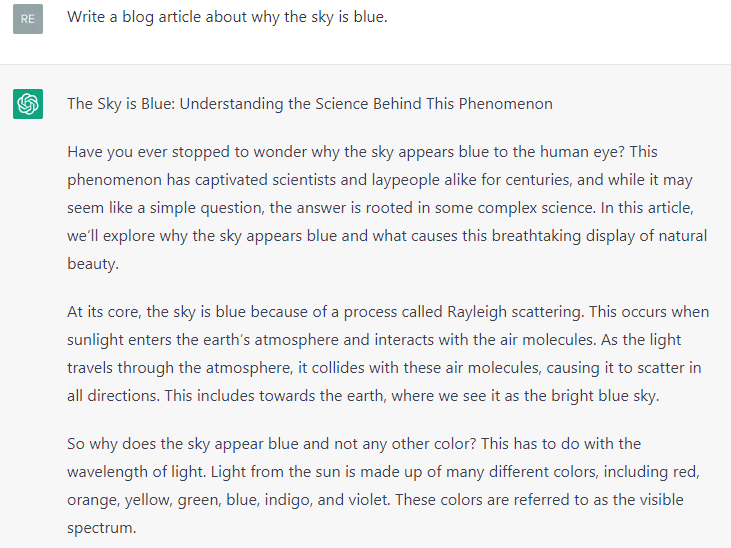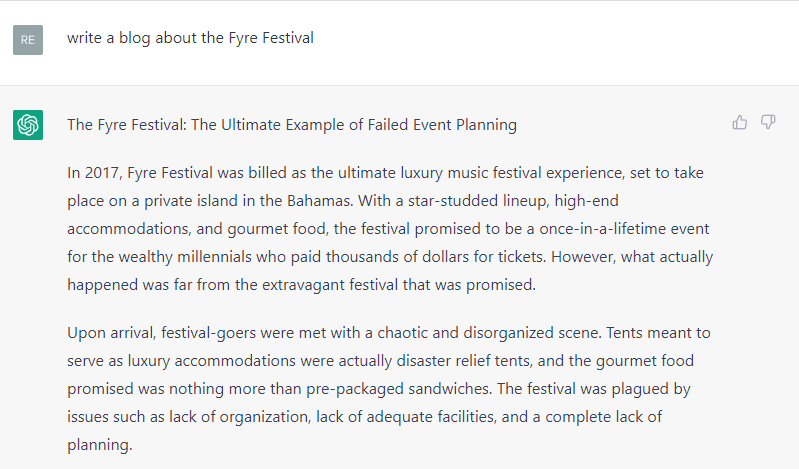Experience firsthand how Mind & Metrics + Supered.io can help your business streamline execution, eliminate unnecessary back-and-forth, and ensure AI accelerates growth—without the chaos.
Want to Use ChatGPT for Blogging? Watch Out for These 5 Issues
ChatGPT is OpenAI’s newest creation: a bot designed to respond to user prompts with informative copy written in a conversational tone. It has the ability to build on its own arguments, correct past mistakes, answer follow-up questions, and argue against incorrect statements.
It’s certainly an advanced AI, in that it’s intelligent enough to carry on a back-and-forth in a contextually relevant way. And it has generated a lot of well-deserved buzz around the internet and in multiple industries. But is it good enough to write a blog by itself without any fact-checking or proofreading?
Sources say: not quite.
On paper, it seems like an ideal machine for blog writing, but it has its limitations. Don’t assume it’s able to write perfect copy on the first try, or even the second or third try. And don’t think you won’t need to edit what it’s written, either, especially if you’re trying to use it for long-form content.
Despite the issues you may encounter while using it, the AI can be employed in useful ways. Here are some of the most common issues that you may run into while using ChatGPT for blogging, as well as the ideal use cases for this AI.
1: ChatGPT sometimes writes inaccurate content.
OpenAI developers have tried to train ChatGPT to provide accurate information, but the AI’s output sometimes falls short. The company states that ChatGPT "sometimes writes plausible-sounding but incorrect or nonsensical answers”.
In fact, Silicon Valley AI developer Peter Relan estimates that the AI “hallucinates”, or makes up information, about 15-20% of the time.
In one article from December 2022, ChatGPT can be seen giving wrong answers to questions like, “what is the largest country in Central America that isn’t Mexico?” (the answer is Honduras, but ChatGPT said Guatemala).
The danger here is that business owners, feeling like they need to stay current with AI trends, then make decisions based on bad information they receive from ChatGPT. If the information sounds plausible, they may not think to verify that it’s actually true. They may end up like Michael Scott from The Office, misunderstanding information like the plot of Romeo and Juliet:

2: The AI generates excessively long sentences and repeats information.
OpenAI admits that ChatGPT can be “excessively verbose”. It was trained to give comprehensive answers, often at the expense of readability.

(Just one more The Office reference couldn’t hurt!)
You can see below, when I gave it the prompt “write a blog article about why the sky is blue”, it writes something accurate, though quite simplified. It’s also fairly repetitive and, well, verbose. The middle paragraph says the same thing twice, and in the last paragraph it takes the time to list all the colors of the rainbow.

A human might write something like: “The sky is blue because of a process called Rayleigh scattering, in which sunlight enters the Earth’s atmosphere and collides with the air molecules, causing the light rays to scatter in all directions.”
Content should ultimately be created to be helpful and useful to your prospects and clients. Long-winded sentences and repeated information within your content will drive up bounce rates on your website and slowly chip away at your E.A.T efforts for SEO, working against you in the long run.
3: The AI can be confused or misled by the phrasing of prompts.
Remember what we mentioned earlier about hallucinations?
Users have been able to trick ChatGPT into giving wrong or misleading information by inputting a prompt that was doomed from the start. One example of such a prompt is “Write a positive review of Fyre Festival”. Despite all the news out there that the Fyre Festival was an absolute failure, when given instructions to speak about it positively, the AI did so.
The key to getting the most honest answer possible out of ChatGPT is to avoid telling it what to think. In the above example about Fyre Festival, the AI was guided in the wrong direction. However, if you give it a prompt to simply, “write a blog about the Fyre Festival”, it will spit this out:

The information it gives here is much more accurate.
ChatGPT tends to do better with the most straightforward prompts possible. Though even with unbiased prompts, the AI may still hallucinate, so it’s important to fact-check when it makes definitive claims.
4: The information that ChatGPT gives is not always current.
ChatGPT was trained with information from 2021, so the answers it gives have a time cutoff. If you’re trying to get it to write about very timely or recently evolving topics, you’ll have a difficult time getting the most accurate answer.
Writing ultra-timely content may not be the most suitable use case for this AI.
5: The character limits and wordiness make it difficult to use for long-form content.
ChatGPT content is limited to 1,000 characters at a time. If you want to write anything of significant length you’re going to need to write it in parts.
As an experiment, email marketing service Selzy wrote an article with ChatGPT that eventually clocked in at around 4,500 words. The results were iffy.
They planned out what they wanted the article to be about beforehand, and made an outline with a descriptive heading for each section. They then used the headings to come up with prompts for the AI. Each section had its own prompt.
After the article was done, Selzy used third-party tools to test the article for readability and plagiarism. The readability score was generally quite low due to how wordy the sentences were. It did pass the plagiarism check, but just barely.
If you want to use ChatGPT to write long-form content, it’s best if you work with an outline, and plug in separate prompts for each section, as Selzy did. The sections will most likely not be as cohesive as you’d like, but the result will be more organized if you go in with a plan.
In addition, you want to keep your reader in mind. Is the content you’re creating driving value?
Best use cases for ChatGPT
AI is capable of writing blog content, but whether that content is a suitable replacement for content written by humans is a different story.
You can use an AI to help you write blog content, without relying on the bot to come up with the blog in its entirety. ChatGPT can be helpful for generating ideas and inspiration. If you’re having difficulty getting your article started, and that blinking cursor and blank word document is taunting you, a few AI-generated paragraphs could be used as a springboard. Take the ideas the AI brings up and use them to inspire you, or edit the AI-generated response to meet your standards.
Since ChatGPT is made to generate conversational content, if you’re writing about a technical subject you might find that the bot tends to simplify complex concepts. This may or may not be what you are looking for. But know that despite its verbosity, it likely won’t delve into all the details of a complicated matter.
Since customer experience is the new battlefield for brands, making sure when all is said and done that your content is valuable to the kind of people you want to attract is paramount to your content creation efforts, with or without AI bots.
Looking for more marketing advice that was written by a human? Check out our blog post on how to know when your website is in need of an upgrade.

